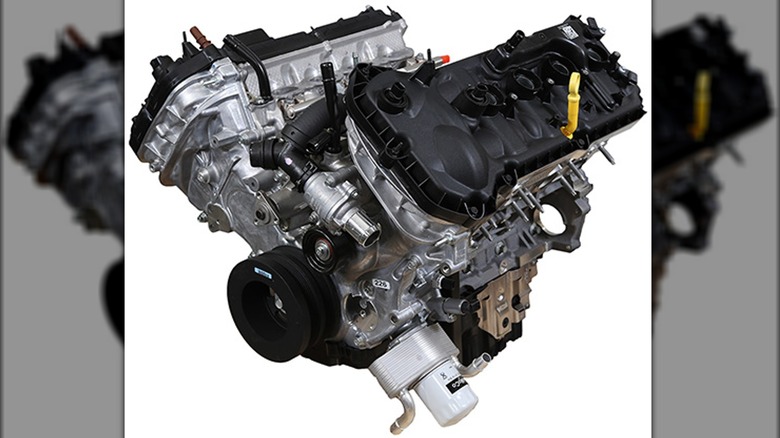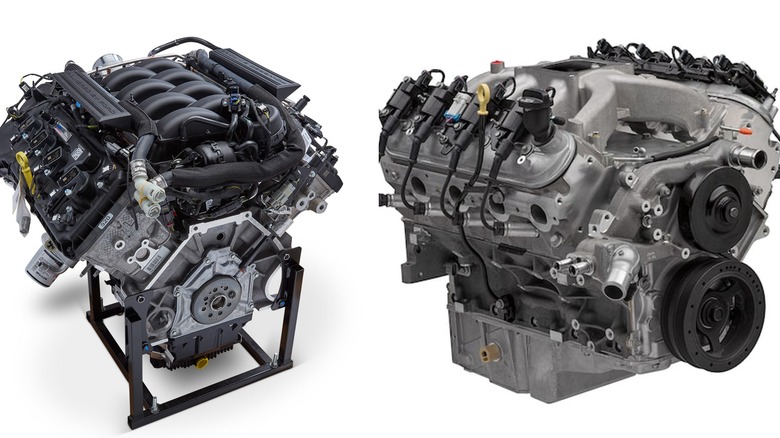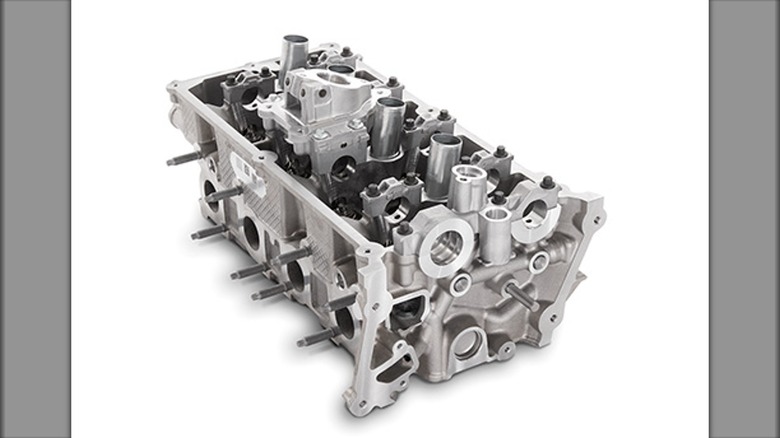Here's Why Ford's Coyote Engines Look So Much Bigger Than General Motors' LS V8s
Comparing Ford and General Motors isn't anything new, especially when it comes to the performance aspects of any motor group's beloved vehicles. Many an intense conversation has evolved around pickup truck towing and payload, the cornering ability of Chevy Camaros compared to Ford Mustangs, and quarter-mile elapsed times of any make and model from either automaker.
During the muscle car era of the late 1960s and early 1970s, American automakers dove headfirst into the "bigger is better" theory, giving rise to the notion that "there's no replacement for displacement." However, since big block engines fell from grace in the mid-1970s due to their inefficient operation, small block V8s have filled the void with resounding success.
Modern small bock V8s were so successful that they've inspired numerous swaps into almost every car imaginable. While swapping powerful engines into seemingly inappropriate vehicles is nothing new — wheel-standing AMC Gremlins stuffed to the fenders with high-horsepower V8s from the 1970s spring to mind — swapping in a Ford Coyote or GM LS crate engine is a high-tech proposal these days. But if they're both small blocks, why does the Ford Coyote engine look so much bigger than GM's LS engine?
Ford Coyote engine vs. General Motors' LS
General Motors introduced the world to the LS1 engine in the 1997 Chevrolet Corvette, while the Ford Coyote didn't come out until 2011 in the Mustang GT. Both engines have evolved over the years, but the latest Coyote variation produces up to 480 horsepower and 420 pound-feet of torque from its naturally aspirated 5.0-liter displacement. That's a substantial gain from the Gen I 2011 Coyote 5.0's 412 horsepower and 390 pound-feet of torque.
The original LS1 produced 345 horsepower and 350 pound-feet of torque in the 1997 C5 Corvette. Newer LS variants include the 6.2-liter LS9, which delivered up to 638 horsepower and 604 pound-feet of torque in 2009-2013 Chevy ZR1 Corvette models thanks to its supercharger's forced air induction.
So why does the smaller displacement, lower powered Ford Coyote engine appear larger than the LS from GM? The size difference directly results from the configuration of each engine's valve train.
What's different about the Coyote 5.0 valvetrain?
The LS engine uses one camshaft that is centrally located above the crankshaft between each bank of cylinders. A timing chain connects the camshaft to the crankshaft to maintain the required precise relationship while the assembly rotates. The camshaft lobes drive lifters with pushrods that activate rocker arms on top of the cylinder heads to open one intake and one exhaust valve per cylinder.
In contrast, the Ford Coyote 5.0 employs four valves per cylinder (two intake and two exhaust) to make respectable power without forced air induction. The Coyote's real trick, and the reason the Coyote engine appears larger, is the dual overhead camshaft arrangement. Instead of a single, centrally located camshaft, the Coyote uses four camshafts, two on top of each cylinder head.
This dual overhead cam setup reduces the number of moving valvetrain components, and allows the Coyote 5.0 to rev higher than otherwise possible. It also requires taller, wider valve covers and larger timing chain housings. The larger valve covers make the engine about six inches wider than at least one LS variant — as measured side-by-side from the folks at EngineLabs. While the Coyote is wider, it's a few inches shorter from top to bottom than the comparable LS engine.


